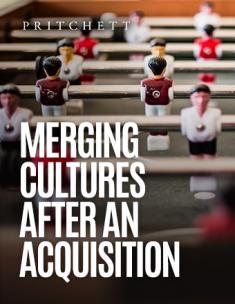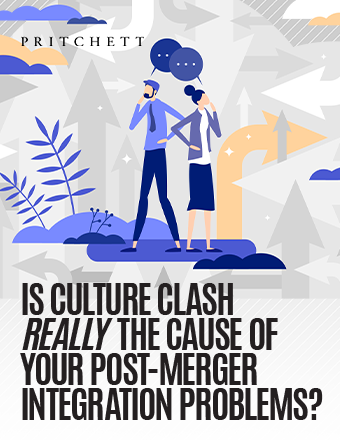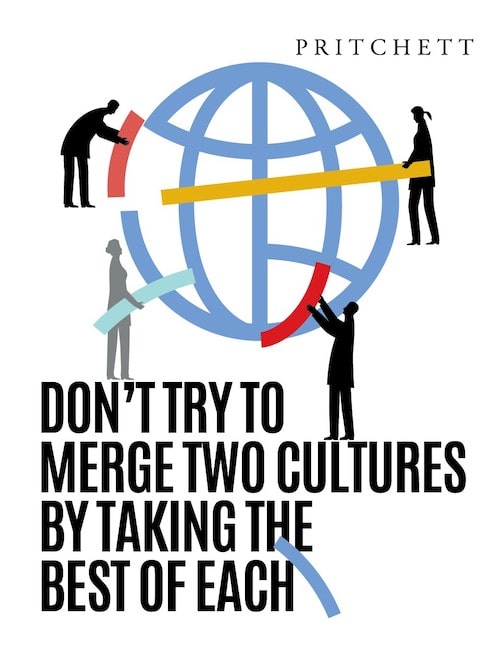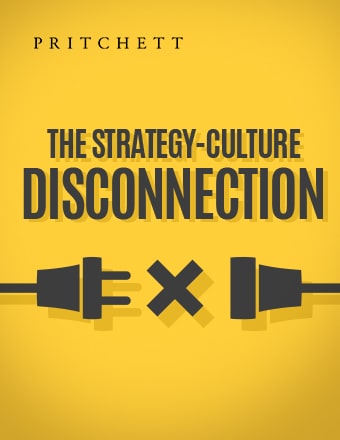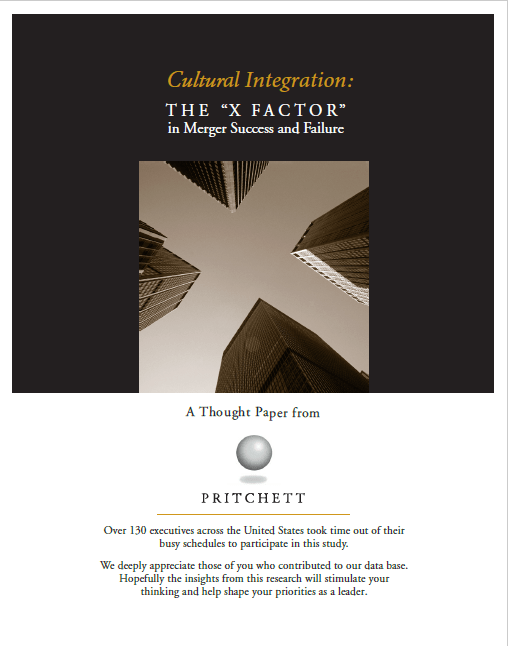Introduction
The biggest obstacle to successful merger integration is conflicting corporate cultures. The disturbing statistics of merger failures document the problem: Between one-half and three-fourths of the deals that are done never measure up to original expectations.
The companies find they can’t live together. Sometimes they stay together, only to fight and feel miserable because their organizational values and lifestyles are incompatible.
Corporate Culture: The Organization's Personality
Just what is “corporate culture”? Why is it so important? How does it exert such a profound influence over an organization and the way employees think, feel, and act?
If you want the cleanest, most straightforward definition of corporate culture, think of it as corporate personality.
Usually, when we think of personality, we think of the individual person. That’s a good place to start. Think for a minute or two. And identify three things that, in your opinion, represent very fundamental, core aspects of your personality. You might conclude, “I’m a true extrovert,” or “I’m a wallflower.” Perhaps you see yourself as highly aggressive, or as having a very understated personality. Maybe integrity is a hallmark of your makeup as a human being, or possibly you take pride in your genuine empathy for others.
Just off the top of your head, what comes to mind as two or three traits, characteristics, or attributes that you think are keys to your personality makeup?
Then, ask yourself how easy it would be for you to take one, two, or all of those traits and turn them 90 or 180 degrees. Could you remake yourself in terms of those characteristics? How easy would it be to overhaul your personality so that core dimensions such as these no longer describe or fit you?
There is a basic assumption about people that can be made here: People don’t change.
The conventional wisdom is that the individual personality has crystallized to an amazing degree by the time a child is school age. Agreed, a child continues to develop and fine-tune the personality through adolescence and even into adult years. But it’s the sameness of the personality, the constancy, that is so striking as the years go by.
People can usually look at their own children, or maybe certain aspects of their own personality, and say, “This child of mine seems to have come into the world made this way or that way,” or “I’ve been that way as long as I can remember.”
It is very hard to change people. When someone says, “I don’t like this thing about me, I don’t like my personality, and I think I’m going to change it,” that person has a heavy-duty job to perform. Even if the individual says, “Well, that’s probably true. I’ll get some special help from a psychologist, or I’ll get some coach, psychiatrist, teacher, or whoever, to work with me in changing this central part of my personality makeup,” it still will be a very, very sluggish struggle with limited returns.
Personality is extremely resistant to change, and that’s why the best predictor of future behavior is past behavior. Granted, it’s not a perfect predictor, but it’s probably the best single predictor managers will find.
That’s why it is unwise to hire people—or marry people, for that matter—with the idea that they can be “rehabilitated” after the fact. This sounds like a rather fatalistic and narrow belief. But there is a second basic assumption about people: People can change.
So when do people change?
It isn’t likely to happen to any significant degree when people just decide for themselves that they are going to change. It doesn’t occur very much even when they seek assistance from a helper or a professional person.
Personalities change, in significant ways, when the world hits them. When they are impacted by something from the external world, something that absolutely knocks them off the tracks they run on, they can change. Things like the following:
- A brush with death
- The loss of a child or some other loved one
- A profound religious experience
- Coming into sudden wealth (or the reverse)
- A rapid rise to fame
Events such as these can produce a distinct personality shift, because they make people reframe the way they look at the world, the things they value, what their priorities are, and so on.
The Difficult Task of Culture Change
But enough about the individual person—back to the subject of the organization, the corporation, and the corporate personality.
Organizations are like people in many ways. They are made up of people, and lots of times they are talked about with the same terminology. Again, there are two very solid assumptions that can be made:
- Companies don’t change very much, in and of themselves, in the routine, day-to-day corporate world of going about doing business. Maybe the company grows a little bit, makes a respectable profit, and experiences evolutionary change. But companies are unbelievably consistent and stable in terms of their personality dimensions.
- Companies can change. They do change. But usually when this change occurs, it is not because somebody at the top—maybe the executive committee, perhaps the company president—sat down and said, “Look, we don’t like this aspect of our personality or corporate culture. And we don’t like that aspect either. Let’s just reshape it."
Once again, they’re taking on a big job. It will be a tremendous struggle.
But if companies can change, and we know they do, when does it happen?
Companies, like people, may show a significant change in corporate personality when the world hits them from the outside. That kind of external impact can come from a merger or from being acquired. Other blows sufficient to reshape corporate culture might be a flood of foreign imports, a devastating legal battle, dramatic technological changes, key governmental actions, and maybe even a sweeping reorganization of a firm.
Major changes in the real world in which the corporation has to live, work, and make a profit can produce meaningful changes in personality.
Once again, though, there has to be something strong enough or meaningful enough to cause an organization to question its priorities or reexamine its values. Plus, there must be a new set of “reinforcers” strong enough to support significant shifts in the way the organization collectively thinks and behaves.
Many companies go through major reorganizations and never experience any culture change whatsoever. And, of course, there are firms that do get hit by powerful forces such that they should change and adapt, but they never do. Sometimes these companies die. Sometimes they end up part of the merger/acquisition casualty statistics, precisely because in the collision of cultures they lose their psychological identity and never recover.
Much is being written about corporate culture these days. One result of this is that some of the popular thinking in corporate circles seems to be, “Well, if we don’t like our culture, we’ll just go forth and change it.”
There are a lot of senior executives who are kidding themselves.
Over three decades ago, Fortune magazine carried a feature story on the subject, with the author concluding:
"Corporate culture is real and powerful. It’s also hard to change, and you won’t
find much support for doing so inside or outside your company. If you run up
against the culture when trying to redirect strategy, attempt to dodge; if you must
meddle with the culture directly, tread carefully and with modest expectations."
(Bro Uttal, "The Corporate Culture Vultures", Fortune, October 17, 1983, p. 72)
Deal and Kennedy, in their book, Corporate Cultures, that first popularized the idea of corporate culture, made much the same sort of observation. They commented that changing corporate culture “costs a fortune and takes forever.” (Terrence Deal and Allan Kennedy, Corporate Cultures)
Now, it’s very important to distinguish between change, in general, and meaningful changes in the corporate personality. A fact of organizational life is that companies are constantly changing certain habits and practices.
Individuals, too, develop new skills, learn new routines, develop new perspectives. But alterations in surface behavior, even new ways of looking at certain things, are not necessarily any good proof whatsoever that personality (or corporate culture) has been changed.
An organization’s personality forms over many years, from many shaping influences. And we can’t change our personality—either as individuals or as organizations—just because we want to do it or see a need to do it.
The existing personality became what it is due to strong reasons, powerful forces. And there will be many strong reinforcers for keeping it as it is. One of the best indicators of whether or not culture is undergoing change will be the level of “resistance” that is seen and felt. Efforts to change personality generally produce a significant amount of resistance or psychological soreness. If managers set out to make meaningful changes and do not encounter resistance, they are not changing culture.
A key function of corporate culture is to bring stability to the organization, just as a key function of personality is to bring stability to the individual. As a result, it is safe to say—in fact, it is very important to say—that culture or personality manages us much more than the reverse.
The question companies must ask themselves, then, is whether there is a real willingness to provoke the resistance and the conflict that culture change will bring.
Will top management see the culture change effort through to completion?
Culture is the critical barrier to change. And the stronger the culture in the first place, the harder it is to change it. Just as the more ingrained a personality trait is, the harder it is to reshape.
In the merger integration process, culture typically stands squarely in the way of some of the transition and change. Of course, the function of culture is to protect an organization from willy-nilly responses to fads or short-term fluctuations.
But cultural influences just happen to be the sort of things that can really cause problems when a firm is being acquired and merged.
The Time Window for Change
Now the good news.
Mergers very often are such a destabilizing event, and have such a powerful impact, that they “break the organizational box,” so to speak. Frequently there is a window of opportunity that develops during which management can do some very profound things in terms of reshaping the corporate culture.
But if that opportunity is not seized, the window soon slams shut, or gradually slides shut, as the case may be.
If time goes by and nothing much changes, people tend to settle back into their same old behaviors and reembrace the same old beliefs and values.
This says two things. First of all, management has an outstanding opportunity to do some things to a corporate system and its beliefs, priorities, and so forth, on the heels of a merger. There is a superb opening (plus a real responsibility) to come forth and lead the organization into the changes that are needed.
To help make the point, think of a situation where a man happens to break a bone in his body. If it’s an arm, even if he doesn’t take care of it, if he just ignores it, it won’t kill him. More than likely the limb will heal itself.
But if the bone is not set properly, what will happen? It’s probably going to grow back deformed, crooked, perhaps weaker. The healing process is very unpredictable and, left without a splint or cast, you don’t really know what the arm is going to look like after the bone grows back together.
The same type of thing happens when opportunities for culture change aren’t managed in a knowledgeable, strategic fashion. Successful culture change efforts are those that proceed in a deliberate, purposeful fashion—where top management knows where it’s headed.
If a merger comes along and shakes up corporate culture, and top management doesn’t really know what it wants to change the culture to, it may grow back together but be crippled, deformed, and unable to function in an effective manner.
When companies merge, their differences in culture are usually a major contributor to employees’ feelings of oppression and confusion. The situation calls for astute management and deep respect for just how complicated it is to manage personality change.
The Impact of Mergers on Corporate Culture
There are several aspects of corporate culture that should be considered in the context of understanding the impact that mergers have on an organization.
One of the key elements is a company’s value system—its basic beliefs. Another fundamental element is the business environment in which the firm conducts business. Then there are also the heroes of the company, plus its day-to-day routines (rituals) and special ceremonies (rites). Finally, there is the cultural network, the informal communication system within the firm.
Deal and Kennedy maintain that the business environment does more to shape corporate culture than does anything else. Essentially, a company’s personality becomes what it is because of the shaping influence of many factors: clients and customers, the competition, the technology that is involved, industry regulations and standards, and the products or services produced.
The many realities of the business world in which a firm operates play a major role in carving out the firm’s character and culture. Some aspects of the business environment have a very subtle influence. But as relentless winds and waters can erode jagged boulders to a smooth finish with the passing of years, so are some cultures gradually shaped by constant pressures from the marketplace.
Other, more dramatic forces in the environment may impact the culture the way an earthquake reshapes the terrain suddenly and destructively.
Mergers affect culture in this profound, sudden, and overwhelming manner. For example, companies frequently acquire firms that come from totally different business environments. Then the parent company, operating from the assumption that its own success can be replicated in the acquisition by having the target firm approach business in the same fashion, destroys the delicate balance between the acquisition’s culture and its business environment.
Corporate Values. The values or basic beliefs are the soul of corporate culture. Employees put their faith in these values, accepting them as the basic answer to "what counts" regarding how business is to be conducted.
A firm’s values are its shared beliefs regarding how success—as an individual employee, or total organization—is achieved. Thus, organizational values carry a heavy influence over what people actually do in an organization.
When companies are being acquired and merged, though, employees get the feeling that the props have been pulled out from under their values or basic beliefs. Nobody knows whether those basic concepts will endure, or how they might be changed.
This adds a tremendous amount of uncertainty, and causes people to become confused regarding just exactly what the company wants and what it takes to get ahead in the new corporate scheme of things.
Employees need to know what their company stands for. Without a good feel for the firm’s values, they become uncertain regarding what standards to uphold. That, in turn, causes management to be unclear regarding decision making.
All too often the merger integration period is a time during which people have difficulty sorting out priorities. There is confusion regarding which tasks are most important, or what information should be given the most weight in making decisions. Frequently, managers feel torn between doing things the way they have been taught they should do them versus the parent company’s new way of operating.
The Corporate Heroes. The people who emerge as key role models in an organization do most to sell others on the corporate values. The heroes make the basic beliefs come alive by living them out as they actually go about performing their jobs.
The heroes are the strong, pivotal figures who command the respect and attention of others. They are the men and women whose achievements become known to everybody else in the firm. Their behavior—their escapades and accomplishments—become part of the folklore of the company. Their actions inspire others while also getting across the message about what it takes to succeed in the firm.
But heroes often leave when firms are being acquired and merged. These high-profile people may sell out, bail out, get terminated, lose their position of influence and prestige, or otherwise fall from grace.
There are implicit messages in this for those who remain:
- If the heroes can’t survive, who can?
- If our best and brightest elect to pack up and move on, should we not follow their lead? After all, they are the role models.
- If we are not to emulate our old heroes, then who will set the standards and symbolize how one becomes a true success in the new corporate framework?
Rites and Rituals. The corporate routines that employees follow as a matter of habit, without ever questioning them, represent a very important aspect of corporate culture. A wide variety of behaviors and practices can be identified as common rites and rituals:
- How people address each other
- Award ceremonies
- How employees “play” together
- The way meetings are handled
- How people talk and act in public
- Standards of dress
- The decision-making process
- Communication patterns in the firm
- Where people park, eat, and office
Virtually always, merging companies do these types of things differently from one another. In fact, what’s acceptable or even encouraged in one organization may be punished in the other.
Invariably, there are enough discrepancies in merging companies’ rites and rituals to make many employees uneasy about the situation. Some people will become very tentative until they figure out what is acceptable protocol in the parent company. Also, it is very common to see the acquirer misconstruing the behavior of acquired company personnel.
Certainly mergers disrupt the rites and rituals of corporate life. Employees don’t know how to handle themselves. They wonder what is expected of them, and frequently become frustrated and angry when their own company’s modus operandi conflicts with the new company’s routines.
There is a real need for merger integration training that coaches people in the specific behaviors—the rites and rituals that top management of the merged organization consider appropriate.
In the absence of this, people have to infer what the company wants and expects of them. That leaves too much to guesswork, and causes discomfort for employees. Months go by as they try to figure out how they’re supposed to do things. They commit faux pas and embarrass themselves, while offending or annoying others in the parent firm who expect adherence to their established corporate culture.
The Cultural Network. In Corporate Cultures, Deal and Kennedy wrote, “We think that 90 percent of what goes on in an organization has nothing to do with formal events. The real business goes on in the cultural network." (Terrence Deal and Allan Kennedy, Corporate Cultures)
The network is the informal communication system in an organization, the information channel that (a) transmits messages to people throughout the company and (b) helps interpret the significance of the messages for all employees.
People who live and work in an organization eventually learn how the network functions. They become rather savvy and adroit in using it to their advantage. Sometimes it seems that about the only way to get things done or to make sense out of the situation is to use the cultural network.
When companies merge, though, the newcomers to the cultural network are at a real disadvantage. They don’t know how to work the new system, and the old system from their prior organization may be short-circuited or just not particularly serviceable anymore.
Managing Cultural Conflict
Any time two organizations are being merged, there will be cultural conflicts that need to be reconciled. Cultural integration needs to be managed, carefully managed, instead of leaving it for everybody to work out on their own.
All too often, management never really comes to grips with the situation. Several things may account for this:
- Management doesn’t grasp the critical influence of corporate culture on organizational performance.
- There is a lack of insight into the cultural differences between two merging firms.
- Management doesn’t really know how to proceed, and just chooses to let nature take its course.
- Management is preoccupied with other—usually more tangible—matters, such as the financial aspects of the merger.
The reality of the situation, however, is that the success of a merger generally is a function of how well the two organizational cultures have been integrated. And the most important job for management is to manage the cultural integration.
Mismanagement of culture has far-reaching ramifications, and sooner or later they affect the bottom line.
Coaching Points
1. Know thyself. Get a fix on your company’s culture, preferably well ahead of any merging efforts. Organizational
blind spots can wreck mergers, resulting in an acquisition strategy that is doomed to failure at the outset.
2. Get to know the other firm’s culture—in a hurry! If you do that, you will understand why they are doing— and not doing—certain things now, and you will know what you are likely to see them doing in the future.
3. Determine the most significant conflict points between the two cultures (i.e., where is culture change or “corporate therapy” going to be needed?). It helps to know where trouble is coming from when one is planning a problem-solving strategy.
4. Analyze other aspects of culture—in either firm—that should be changed, given that the merger may create a significant window of opportunity to do so.
5. Think hard about this idea of changing corporate culture in the acquisition. Do you really want to take on that struggle? It may make more sense to concentrate on reconciling cultural differences—i.e., learn to live together with some basic differences in corporate personalities—instead of attempting to change deep-seated cultural issues in the acquisition.
6. If you are going to try to change corporate culture, then do it right. Get professional help. Involve an external consultant. At least this improves your odds a bit, and a good consultant can help you cope with the frustrations you’re going to have.
7. Factor corporate culture into the strategic game plan. Remember, corporate culture manages us.

